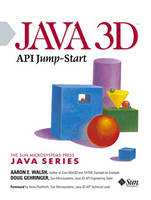
Java 3D API Jump-Start
Prentice Hall (Verlag)
978-0-13-034076-4 (ISBN)
- Titel ist leider vergriffen;
keine Neuauflage - Artikel merken
3D development is difficult, but it is where the web is headed--and headed fast. Why? Because humans crave 3D experiences: we live in a 3D world, after all. Java 3D is an extension of Java, and is considered by many as the most likely 3D technology to succeed in the web development arena. This book is a relatively short (350 pages) introduction to Java 3D and its capabilities, as well as a guide to developers and programmers.
AARON E. WALSH is Chairman of Mantis Development Corporation, a development firm specializing in advanced multimedia and network technologies. An active member of the Internet standards community, Walsh is Chairman of the Web3D Consortium's Universal Media technical working group, Chairman of the Web3D-MPEG group responsible for the convergence of Web3D and Motion Picture Experts Group (MPEG) technology, co-chair of the Web3D Intellectual Property Rights group, and Web3D Liaison to MPEG and the World Wide Web Consortium. An internationally best-selling technology author, he is author of the best-selling Core Web3D, MPEG-4 Jump-Start, and XHTML Example by Example (Prentice Hall PTR) and founding Series Editor of the Prentice Hall Web3D Series. DOUG GEHRINGER is a Staff Engineer at Sun Microsystems and a member of the Java 3D Engineering Team. He has spent the past fourteen years at Sun working on graphics software, and has extensive experience programming for all of Sun's graphics APIs, including GKS, PHIGS, PEX, OpenGL, and Java 3D. A respected expert on graphics performance tuning for large-scale applications, he has worked on a number of the largest Java 3D projects in existence. One of the first developers in the world to use Java 3D, he co-authored the original Virtual Reality Modeling Language (VRML) that is today maintained by the Web3D Consortium. An active member of the Java 3D community, Gehringer is Java 3D technical editor of the best-selling Core Web3D (Prentice Hall PTR) and author of the Java 3D Explorer companion application created exclusively for Java 3D Jump-Start readers.
Foreword.
Introductory Note.
Preface.
1. Java 3D Overview.
Digging into Java 3D. Java 3D in Action. Java 3D Design Goals. Digging Deeper: Comparing Java 3D to Other Graphics Options. Java 3D versus Low-Level Rendering APIs. Java 3D versus Other Scene Graph APIs. Java 3D versus Modeling File Formats. Java 3D versus Other Java Media APIs. Hitting Pay Dirt: Exploring Key Java 3D Features. Scene Graph Programming Model. Rendering Control. Java 3D Rendering Model. Scalable Performance. Behaviors. Geometry Compression. Sound. Convenience and Utility Classes. Versatile View Model. Java 3D and the Java Platform. Java 2 JDK, JRE, and the Java Plug-In. Java and Java 3D. Java 3D Packages. Java 3D Documentation. Java 3D Versions. Platform Support. Platform Variations. Java 3D DirectX versus Java 3D OpenGL. Java 3D Resources. Summary. Summary of URLs Found in This Chapter.
2. Scene Graph Basics.
Firing Up HelloUniverse. Stepping into a Virtual Universe. Scene Graphs. SceneGraphObjects. Group Nodes. Environment Nodes. The ViewPlatform. The VirtualUniverse and Locale. Exploring the HelloUniverse Scene Graph. Working with the Scene Graph. Scene Graph Interpretation. Making Changes to the Scene Graph. Capability Bits Details. More Optimizations: compile(). Other Scene Graph Operations. Groups. Group Subclasses. BranchGroup. OrderedGroup. SharedGroup. Switch. TransformGroup. Groups in HelloUniverse. Recipe for a Java 3D Program. Summary.
3. Creating and Loading Geometry.
Shape3D Nodes. Geometry. GeometryArrays. Geometry Utilities. Text3D. Higher-Level Primitives. ColorCube. Text2D. Utility Shape Primitives. Loading Geometry from Files. The Loader. The Scene. Loading Other File Formats. Java 3D Fly Through. Summary. Summary of URLs Found in This Chapter.
4. Appearances.
Appearance Basics. Appearance Attributes. Color Classes. Appearance Methods. Examining Appearance Attributes with Java 3D Explorer. ColoringAttributes. PointAttributes. LineAttributes. PolygonAttributes. RenderingAttributes. TransparencyAttributes. Material. Texture Mapping. Texture. TextureAttributes. Assigning Texture Coordinates. TexCoordGeneration. Multitexturing. Summary. Summary of URLs Found in This Chapter.
5. Environment Nodes.
Environment Nodes in the Java 3D Explorer. Bounding Regions. Lighting. Backgrounds. Fog. Sound. Behaviors. Bounding Regions. Summary. Summary of URLs Found in This Chapter.
6. Tools: Transformation, Viewing, and Picking.
Transformations. Transformations with Java 3D Explorer. Basic Transformations. Transform3D. Compound Transformations. Hierarchies. Controlling Transforms with Mouse Behaviors. Viewing. Moving the ViewPlatform. Basic Viewing: Finding a Good Vantage Point. Moving the ViewPlatform with the Mouse. Changing the View. Advanced Viewing. Picking. PickTool. PickCanvas. PickResult. PickIntersection. Other Uses for Picking. Summary.
Appendix A: Transformation Details.
Index.
| Erscheint lt. Verlag | 4.9.2001 |
|---|---|
| Verlagsort | Upper Saddle River |
| Sprache | englisch |
| Gewicht | 555 g |
| Themenwelt | Informatik ► Programmiersprachen / -werkzeuge ► Java |
| Mathematik / Informatik ► Informatik ► Web / Internet | |
| ISBN-10 | 0-13-034076-6 / 0130340766 |
| ISBN-13 | 978-0-13-034076-4 / 9780130340764 |
| Zustand | Neuware |
| Haben Sie eine Frage zum Produkt? |
aus dem Bereich


